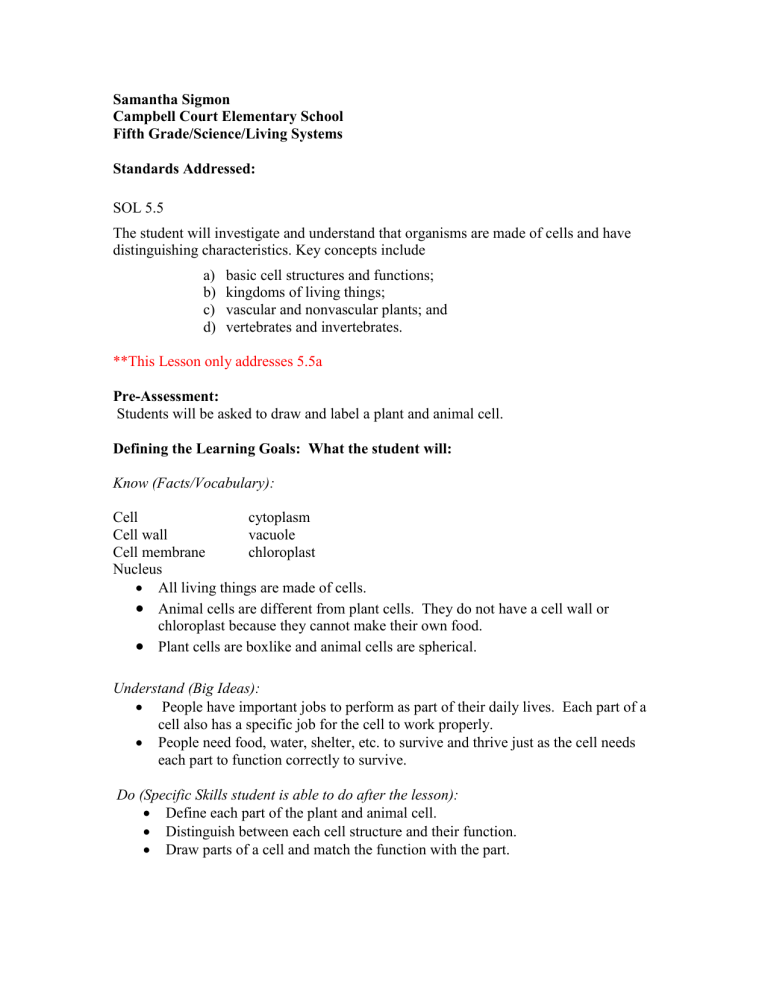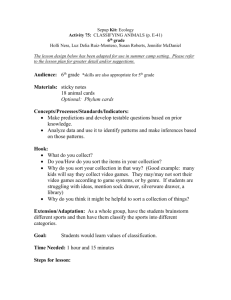Bloom's Taxonomy

Samantha Sigmon
Campbell Court Elementary School
Fifth Grade/Science/Living Systems
Standards Addressed:
SOL 5.5
The student will investigate and understand that organisms are made of cells and have distinguishing characteristics. Key concepts include a) basic cell structures and functions; b) kingdoms of living things; c) vascular and nonvascular plants; and d) vertebrates and invertebrates.
**This Lesson only addresses 5.5a
Pre-Assessment:
Students will be asked to draw and label a plant and animal cell.
Defining the Learning Goals: What the student will:
Know (Facts/Vocabulary):
Cell
Cell wall
Cell membrane cytoplasm vacuole chloroplast
Nucleus
All living things are made of cells.
Animal cells are different from plant cells. They do not have a cell wall or chloroplast because they cannot make their own food.
Plant cells are boxlike and animal cells are spherical.
Understand (Big Ideas):
People have important jobs to perform as part of their daily lives. Each part of a cell also has a specific job for the cell to work properly.
People need food, water, shelter, etc. to survive and thrive just as the cell needs each part to function correctly to survive.
Do (Specific Skills student is able to do after the lesson):
Define each part of the plant and animal cell.
Distinguish between each cell structure and their function.
Draw parts of a cell and match the function with the part.
Materials/Supplies:
Smartboard sort
Blank flashcards
Art supplies
Group assignment sheets
Procedures/Activities (Include Marazano's Strategies and Bloom's Taxonomy):
Marazano’s Strategies
__X__Identifying Similarities and Differences
__X__Summarizing and Note Taking
__X__Reinforcing Effort and Providing Recognition
__X__Homework and Practice
__X__Nonlinguistic Representations
__X__Cooperative Learning
__X__Setting Objectives and Providing Feedback
__ __Generating and Testing Hypotheses
__X__Questions, Cues, and Advance Organizers
Bloom’s Taxonomy
__X__Remembering
__X__Understanding
__X__Applying
__X__Analyzing
__X__Evaluating
__X__Creating
Day 1:
Students will complete the pre-assessment. Students will be put into groups according to prior knowledge to research a specific part of a cell, including the cell wall, cell membrane, cytoplasm, chloroplast, vacuole, and nucleus. Students will complete drawing and function page of the cell structure. Students will come together as a whole group to share their findings. Students will take notes on given structure on their notes page.
Day 2: Students will review parts of the plant and animal cell. Students will complete a learning styles lesson on the structures and functions of the plant and animal cell.
Group 1—Sensing Thinking Students
Students will work together to label the parts of a plant and animal cell and their functions using the Smart Board sort.
Students will then list each part and its function. Students will also include a drawing of each structure.
Group 2—Sensing Feeling Students
Students will independently create a sort for the parts of a plant cell.
Students will include the structure in word form, a picture, and its function.
Students will trade sorts and complete each other’s sort and check for accuracy.
Group 3— Intuitive Thinking Students
Students will draw, label and write function of each of the cell structures. Then, students will pick one part and write a brief paragraph explaining why this structure is important in the functioning of the other parts of the cell and explain what would happen if that particular structure failed to work properly.
Group 4—Intuitive Feeling Students
Students will list and draw each cell structure and define the functions of those parts.
Students will then create a symbol to help him or her remember each part and function.
Day 2: Students will complete post-assessment.
(If) Differentiated Instruction:
What? content process product
How? readiness interest learning profile
Why (What prompted you to differentiate in this way)?
Anchor Activities:
AR books on living systems
Solpass.org to review 5.5 living systems
Post-Assessment:
Students will complete diagram page, in which they will label and write function of the plant and animal cell.
Closure:
Students will review with teacher what was learned.
Teacher Reflection:
(What went well? What would you do differently? Why?)
Group 1—Sensing Thinking
Step 1: Work together to label the part and function of each of the parts of a plant cell using the Smart board sort.
When completed, raise your hand for the teacher to check your work. Then, label the parts and functions of an animal cell.
Step 2: Make a list of parts and their functions independently. Make sure to also include a drawing of each.
Directions: List the parts of a plant cell and their function. Make sure to include a drawing of each.
5.
4.
6.
3.
1.
2.
Structure Drawing Function
Group 2—Sensing Feeling
Step 1: Work independently to create a sort for the parts of a plant cell and their function. For each structure, you need to include a card with that name, a picture, and the function. Each group of three is a match.
Step 2: Trade sorts with a friend and complete their sort while they complete yours. Check each other’s work.
Group 3—Intuitive Thinking
On the paper provided, list each plant cell structure, draw a picture of the part and list its function. Then, pick one of the cell structures and explain why this structure is important in the functioning of the other parts of the cell and tell what you think would happen if that particular structure failed to work properly.
Structure Picture Function
The importance of the ________________ is _______
___________________________________________
__________________________________________.
What do you think would happen if the structure you chose failed to work properly in the cell?
___________________________________________
___________________________________________
__________________________________________.
Group 4—Intuitive Feeling Students
On the paper provided, list and draw each cell structure and define the functions of those parts. Then create a symbol to help you remember each part and function.
Structure Actual Picture Function Symbol






